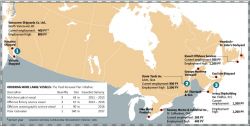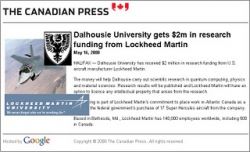Halifax Media Co-op
News from Nova Scotia's Grassroots
Shipbuilding Yes, But Not the Militarization of Shipbuilding
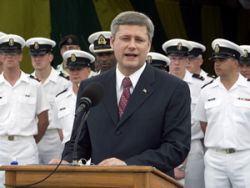
Admiral Harper speaks onboard the Canadian frigate HMCS Fredericton in the Caribbean, July 19, 2007, while on a visit to Colombia, Chile, Barbados and Haiti. The Canadian frigate was deployed as part of “Op Caribe,” a war exercise aimed to build “maritime domain awareness.”

Gustav Krupp greets Reichsführer SS Heinrich Himmler at the launch of Navy cruiser Prinz Eugen from the Krupp Germania Werft yard at Kiel. Krupp was convicted of crimes against humanity by the Nuremberg Tribunal. His sentence was commuted by the USA.

The first thing about the alternative is to reject the logic of there being “no alternative” – except to join the Irving empire to fight for “Atlantic Canadian jobs” or to side with some other monopoly group.
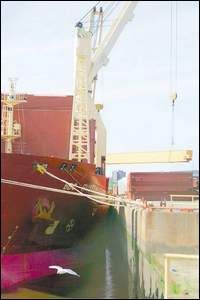
Machinery from Irving’s Saint John shipyard being loaded on the BBC Russia for transport to Mumbai, India on May 8, 2006. (Telegraph-Journal photo)

Irvings are the greatest polluter in New Brunswick. Photo shows its notorious Saint John pulp and paper mill – Alex Vye, 2003

Map of the sea routes that the Atlantic Gateway is contending for reveals the extent of the global ambitions of the Irving empire and the political and economic elite.
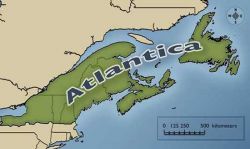
Map shows U.S. and Canadian territory to come under the dictate of this annexationist project. Since this map was published, Newfoundland and Labrador have been incorporated into the Atlantic Gateway project.
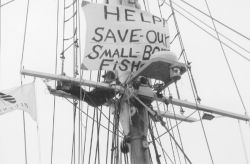
Fisherman Fred Sears, occupying the Bluenose on the Halifax waterfront. Hook and line fishermen courageously fought for a human-centred solution to the fisheries crisis against the corporatization and privatization of the fisheries by the Department of Fisheries and Oceans in service of monopoly right.
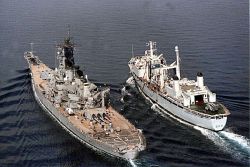
The HMCS Protecteur, one of the supply vessels to be replaced in the Joint Support Warship contract, fuels the American warship USS Wisconsin in the Persian Gulf in this 1991 file photo.
- This article was revised and updated on June 8, 2011
SHIPBUILDING is one of the traditional industries in the Maritimes, Quebec, certain lake ports in Ontario, and British Columbia which is in crisis. Now, instead of resolving the crisis in favour of the people, the warmongering positions of the Harper government include the militarization of all shipbuilding. In Nova Scotia the suggestion always hangs in the air that the militarization of the economy and the $20 billion war budget are the solution to the economic crisis and regional disparities and it is a matter of “buy Canadian” or “buy Nova Scotian” versus outsourcing, either abroad or to another region such as Quebec.
The consequences of the militarization of the economy and the self-serving aims it is put are kept in the shade.
Politically, of the different political parties, only the Marxist-Leninist Party of Canada presents the necessity for a nation-building project that includes shipbuilding, merchant marine, the fisheries and the steel industry.
Harper’s Armada
Ottawa is planning a massive expansion in the preparations for bloody war and foreign intervention in the service of the U.S. empire, but a war profitable for the big bankers, and there is furious bidding for fabulous military orders. Harper’s “Canada First Defence Strategy” involves a military budget of $490 billion.
The bidding for the federal contract for Harper’s $35-billion National Shipbuilding Procurement Strategy, involving the construction of as many as 100 vessels, opens on May 18. On that date all competing shipyards in Canada must provide proof of ownership to compete. The short listed shipyards have until July 7, 2011 to submit their proposals. Two yards will eventually be designated “centres of excellence” for building combatant (Class A) and non-combatant vessels (Class B). The main immediate prize is an over $3 billion contract for three new massive warships – Joint Support Ships – for the Canadian Navy. New combat warships to replace the 12 Halifax-class patrol frigates, launched in the 1990s but expected to reach the end of their life around 2025, is another prize.
Irving Shipbuilding, whose main shipyard is in Halifax but is headquartered in Saint John, NB, is feverishly campaigning to be designated for both “centres” – not just one. [1]
Since Harper came to power and especially since the 2008 federal elections, the program has been enveloped in controversy, revisions and peculiar delays. The strategy was finally announced in June 3, 2010 but has again been amended in October 2010, in the sphere of the design of the joint support warships, seemingly to accelerate their construction.
In February, 2011, Mackay’s spokesman, Jay Paxton, playing down reports that Canada was secretly negotiating with Britain and BAE Systems Inc. (with whom Irving is linked) to become part of a so-called Global Combat Shipprogram, reportedly involving the navies of Australia, New Zealand, Malaysia, Turkey and Brazil, stated “Every new ship that Canada builds for the Canadian navy will be built in Canada.” [2]
The joint support warships contract involves a more than $3 billion program for the transfer of public funds to private shipbuilding and armaments monopolies. It was originally initiated by the Chrétien Liberals and adopted by Paul Martin in April 2004 as part of the “modernization” and “transformation” of the Canadian Forces which then U.S. Defence Secretary Donald Rumsfeld and the Pentagon demanded from the NATO “allies.”
To satisfy this demand, Harper and MacKay put into place new tendering arrangements for domestic and foreign monopolies under the pretext that the previous design specifications were too high. To elaborate: this would have included at that time $324 million for the procurement, operation and maintenance of six new coast guard vessels – as well as the previously announced $2.9 billion joint support ship procurement, which is now estimated to cost up to $3.5 billion alone. In the fall of 2009, the Halifax Shipyard then landed a contract worth $219 million to build nine mid-shore patrol vessels for the Canadian Coast Guard. The Coast Guard ships are being modernized as part of the contention of vested interests for Arctic shipping routes and oil reserves, the “benefit” of climatic change. Included in that timeframe is the deepwater port refueling capability at Nanisivik, a new strategic fuel resource in Nunavut which will be used by all government departments, including the Coast Guard. The Canadian Coast Guard, whose prosecution of tankers for oil spills has been cut by fully one third since 1994, has been brought under the command of U.S. Homeland Security since 9/11 as part of the new U.S.-Canadian “security” arrangements.
The three naval “joint support ships” to be commissioned were originally envisaged to be massive state-of-the-art command-and-control warships, unique in the world. They were being positioned to become a principal weapon for offensive operations in the seven seas of the world, wherever the U.S. Empire has need of them.
This came at a time The U.S. Navy – Status of the Navyrevealed that 92 per cent of its surface ships were obsolete or deployed. The “joint support ships” combine a supply and provisioning role for forward combat operations and a command centre, capable of directing amphibious invasions of coastal and sovereign countries. According to Wikipedia, “The Joint Support Ship will enable a Naval Task Group to remain at sea for up to six times longer than is currently possible.” They were envisaged to be far superior in high-tech electronics and armour than anything afloat.
This explains the global dreams and megalomaniac ambitions of the ruling elite. Vast sums in the tens of billions of dollars – far greater than the $3 billion – were at stake by meeting the U.S. demand that Canada pay a far greater share of the defence of Fortress America and the Canadian Forces be fully annexed under the Pentagon.
In the sphere of naval operations, this can be seen from the systematic deployment of Canadian warships in recent years to the far coasts of Africa, Latin America and the Caribbean, the Black Sea, and the Democratic People’s Republic of Korea as part of the U.S. and NATO fleets and the gunboat policy. Harper’s military “ship procurement strategy” was then deceptively presented as a “Canadian shipbuilding strategy.” However, the neoliberal and imperialistic policies have nothing whatsoever to do with the defence of Canada or developing a modern shipbuilding sector. Nevertheless, they are promoted in the name of a “Buy Canada,” “protecting Canadian sovereignty” and “ensuring steady work for all yards” propaganda.
The policies of Ottawa in military procurement (“defence production”) have always involved arrangements through which finance capital subjugates the assets of the particular sector of the economy involved, as the AVRO Arrow affair famously illustrated. At present, the vicious inter-monopoly competition for the contracts has both a national and international dimension, involving the cartelization of the armaments and shipbuilding sector of the economy within the U.S.-NATO bloc, which has not yet been resolved.
More than meets the eye
There is far more at play here than meets the eye.
The domestic monopolies include the U.S.-owned Kiewit yard in Marystown, Newfoundland, the Irving-owned Halifax Shipyards, the idle MIL-Davie Yards Inc. in Levis, Quebec City (also involving Norwegian and now Italian interests), Port Weller Drydocks in St. Catharines, Ontario, and the U.S.-owned Vancouver Shipyards Co. Ltd.
The German shipbuilding corporation, ThyssenKrupp Marine Systems Canada, though rarely mentioned, also lurks in the background, as does SNC Lavalin with its well-known political and financial links to former Prime Minister Paul Martin, whose family owns Canada Steamship Lines. In February, 2006, both were selected to receive a contract for the Project Definition Phase of the Joint Support Ship project and paid $12.5 million each to develop designs and submit bids by the summer of 2008. (Irving Shipbuilding and BAE were eliminated at that stage.) The designs were subsequently rejected as being out-of-line.
Yet it was then prominently reported that the design of the Joint Support Ships are now to be remakes of one of two European warships, either the GermanBerlin-class (ThyssenKrupp) or the Spanish Cantabria-class design warships (Navantia, SA, the fifth-largest shipyard in Europe) – a significant shift in procurement, design and timetable.
On October 8, 2010 Public Works and Government Services Canada published an Advance Contract Award Notice. It stated:
The Government has approved a new procurement approach whereby National Defence will explore adapting the designs of recently built naval fleet replenishment ships that are operating with other NATO Navies.
Based on information available in the public domain and information received from Allied Navies, National Defence has concluded that the following designs are the only candidates for adaptation:
• The Berlin Class
• The Cantabria Class
The Government intends to award two separate contracts, one to ThyssenKrupp Marine Systems Canada Inc. (TKMS) and the other to Navantia, S.A. (Navantia), to conduct risk reduction studies to ascertain the feasibility of adapting these designs to meet Canadian requirements, to provide the historical cost of building these ships, and to deliver a proposal for the development of suitable modifications to their respective designs and the delivery of a data package for use by a Canadian shipyard to build the ships, a technology transfer agreement and the right for Canada to use the design and all data for the construction, use and in-service support of these ships.
If one of these designs is selected for the JSS, Canada will amend the contract with that designer to implement its proposal.
…
… only TKMS and Navantia are believed to be capable of performing the contracts. [3]
So much for the disinformation that the issue is to oppose “outsourcing.”
These warships not only involve building hulls, at which Canadian shipyard workers are second to none, but also steel as well as foreign armaments, engines and electronics all to be imported, with the potential of huge profits being realized. None of the Canadian-based monopolies have revealed the suppliers with whom they are linked, and none of this is mentioned in the hype about securing the contract for the warships.
In this regard, the British armaments multinational BAE Systems Ltd. (formerly Vickers) is repeatedly speculated in the shipbuilding industry to be interested in buying into Irving Shipbuilding, and Irving is collaborating with the U.S. Lockheed Martin armaments multinational in building a Fundy tidal power station. Lockheed Martin has established an operation right within the bowels of CFB Stadacona, the naval base in Halifax and headquarters of Maritime Command, ostensibly rent free, from which it operates with a sense of permanent entitlement, as we shall below. In 2010, Harper committed the Canadian government to purchase Lockheed Martin’s stealth F-35 fighter jets in a $9 billion no-bid contract now estimated to cost upwards of $30 billion.
The European factor
Harper’s original aim in extending the tenders was to bring new arrangements into being. For instance, efforts have been underway since the early 2000s to forge one European shipbuilding company – a German/French production under the leadership of the ThyssenKrupp Steel and Industry Corporation. However, just as in Hitler’s time, the concentration of the European maritime shipyards under German leadership has so far been thwarted by France’s resistance, which also seeks a predominant position in the production of warships, as does Spain.
ThyssenKrupp, Germany’s largest steel and armaments enterprise, is the largest builder of warships in the European Union which has plans for its own Rapid Reaction Force, distinct from NATO. ThyssenKrupp represents the 1999 combination of the biggest German Nazi armaments trusts (Thyssen and Krupp), which were revived under U.S. leadership after WWII and the rearming of Germany in violation of the Potsdam Agreement. ThyssenKrupp Marine Systems (TKMS) consortium, founded in 2004, consolidated various German dockyards into a shipbuilding consortium, covering a wide ranging spectrum of military production sites in Kiel and Hamburg. ThyssenKrupp, consisting of some 670 companies worldwide, is one of the world’s largest steel producers and has been expanding into the NAFTA and North American carbons steel markets as well as Pakistan. In one of the the surges of direct investment by German monopoly capital in the former U.S. slave states (e.g., Volkswagen, Siemens, Wacker Chemie, Electrolux; even the Nazi names are similar), ThyssenKrupp Steel USA recently completed a $5 billion integrated steel mill in the Gulf port of Mobile, Alabama (as well as another in Brazil), a former slave state without much union organizing. Significantly, this is the first integrated steel mill built in the U.S. in decades.
It is important to remember the important political ties between the Conservatives and Germany highlighted by the Schreiber Airbus arrangements with Brian Mulroney and Elmer MacKay, the former cabinet minister and Karlheinz Schreiber, his “friend” (he put up $100,ooo of his bail in 1999 and gave him shelter at his home), which included plans by Thyssen Industrie AG for an armaments (light-armoured vehicles) plant in Bear Head, near Point Tupper, Nova Scotia, also justified in the name of “job creation.” [4] These arrangements followed the “dump-Clark movement” in 1983, which was financed, in part, with funds from Germany, bringing Mulroney to power.
ThyssenKrupp’s legal staff once included the then-lawyer Peter MacKay in its Kassel, Germany office in 1991 or 1992 (the missing page in his resumé). Now MacKay is Canada’s Defence Minister and the Canadian representative to NATO. As one blogger put it, “you can’t make this stuff up.” [5]
Of course, as part of these arrangements in Canada and especially the United States, where German monopoly capital is putting a certain level of manufacturing back into the southern U.S., the European imperialists expect to receive something, whatever that may be, whether increased pressure against Russia in the Arctic or Canadian naval deployments to the Black Sea and pressure against Russia in Eastern Europe and the Black Sea. It may be connected to consolidating the U.S. military empire in Europe against Russia and expanding NATO worldwide to the benefit of European imperialism and in return not raising objections to U.S. military provocations on the Korean Peninsula or Africa or some other benefit to the U.S. Empire. The point is there is more to the militarized shipbuilding than meets the eye. [6]
The Ship Procurement Strategy, for instance, also involves scores of smaller vessels.
The Harper government, under the banner of “free trade,” has been removing tariffs to allow interests in the European Free Trade Area (EFTA) – Iceland, Norway, Switzerland and Liechtenstein, with direct and indirect links to Germany – to knock off the smaller shipyards and swallow their shrinking market for medium-sized vessels. Under the EFTA agreement negotiated in June, 2007, a key shipbuilding tariff of up to 25 per cent on foreign-built vessels coming into Canada was phased out. [7] Norwegian interests then bought into the MIL-Davie yard in Lévis, Quebec to build oil rigs for North Sea drilling. Although it had $500 million orders on the books, representing five ships [with three ships then under construction], it was put under the shield of the fraudulent federalCompanies’ Creditors Arrangement Act by the Quebec Superior Court on February 25, 2010. That same day it simply threw 1,590 workers – or 90 per cent of the workforce – onto the streets.
At the same time successive Liberal and Tory governments have capitulated to the American dictate in shipbuilding – the exception negotiated in the NAFTA treaty for the U.S. Jones Act, whereby Canada is forbidden to export ships built in this country to the USA. The Jones Act legislates that any cargo carried between U.S. ports must be carried aboard U.S. ships that are U.S.-built, U.S.-registered, U.S -owned, U.S.-crewed – and repaired and serviced exclusively by U.S. firms. Canadian shipbuilders are effectively prevented from selling ships that might be used in the U.S. domestic trades but Canada still allows U.S. shipyards the right to sell new or used ships and barges in the Canadian market – duty free.
The Harper government and the monopolies have also been demanding that shipyard workers make concessions to capital in the name of “restructuring” so as to line up each individual shipbuilding monopoly in each region, the Maritimes, Quebec, Ontario and British Columbia in the cutthroat competition for the ultimate contract.
Here we have the “Canadian Way” – the vision and program of the rich to make the monopolies successful in the global market and enrich the financial oligarchy, as well as an attempt to liquidate the independent movement of the working class and people by imposing on them the neoliberal agenda in the name of job security, national security and national interests.
There Is an Alternative
The alternative becomes apparent the moment one shakes off the disinformation that the issue is one of “insourcing” (“Buy Canadian;” “protecting Canadian economic sovereignty”) versus outsourcing. The self-serving propaganda promotes support for militarization in the service of empire building – so long as the fraudulent “balance” with “jobs for Atlantic Canadians” (or alternatively “jobs for British Columbians” or “jobs for Quebec”) is maintained. In other words, there is no alternative – except who gets the tender! Animosity between regions and workers is stirred up over competition for the tender. Contracts to a shipyard in a depressed region of Quebec are denounced as “political” while contracts to equally depressed Atlantic Canada are deemed “fair” and a sign of entitlement. The shipyard workers are supposed to make every concession imaginable to make their monopolies competitive.
The first thing about the alternative is to reject the logic of there being “no alternative” – except to join the Irving empire to fight for “Atlantic Canadian jobs” or to side with some other monopoly group.
There is “no alternative” only if the workers adopt the outlook of the rich that maximum capitalist profit is the motive force for production, that making businesses competitive in the global marketplace is the first priority, that the government has no responsibility to ensure a livelihood for every member of society and for every region of the country. This is the logic of “no alternative.” In other words, workers, without thinking and without discussion, should accept that it is impossible to have a self-reliant economy geared to providing for the Canadian people’s social, peaceful needs at home and abroad.
The Irving “Alternative” is No Alternative
The consequences of militarization of the economy are brutal, and do not even lead to job creation.
For example, in 1977, the Irvings were awarded a contract by the Trudeau Liberals for nine out of a fleet of 12 warships in the Halifax-class frigate program, with the Davie yard in Lévis, Quebec receiving the other three. The original tender was some $1.2 billion. The 4,750-tonne Halifax-class frigate was built according to U.S. and NATO “standardized” specifications for bluewater operations. Only the assembly took place in Canada. All the armaments and electronic and navigation systems were imported from the merchants of death – a Swedish Bofors main gun, Dutch fire control, U.S. air-search radar, gas turbines, point defence and anti-ship missiles and close-in weapons systems. [8] Frigates designed for coastal defence average around 3,000-tonnes. But theHalifax class was designed in the mid-1970s for outmoded Cold War needs, with specialized anti-submarine capabilities, whereas it was ultimately deployed thousands of miles away from Canada in naval task forces for bluewater interdiction of maritime shipping such as in the Persian Gulf. When they leave Canadian waters these warships come directly under overall U.S. and NATO strategic command.
When the contract was finished in 1996, the Irvings had billed out at over $9 billion from the public treasury, some 800 per cent over and above the original tender. Tens of millions of dollars were spent upgrading the machinery and plant of the Saint John yard. Using this capital, the Irving monopoly took over shipyards in Halifax, Shelburne and Pictou in Nova Scotia and Georgetown in PEI to support the Halifax-class project. Irving Shipbuilding purchased the Halifax Shipyards after it was contracted in the mid-1990s to build the Kingston-class coastal defence vessel by the winning consortium led by SNC Lavalin.
What happened? The workers were forced to surrender their rights. As many as three thousand seven hundred workers had been employed during the construction of the frigates. In April, 2000 the 77-year-old Saint John Shipbuilding shipyard was mothballed. At that time, just ninety workers were left and U.S. shipyards were staging recruiting fairs in Saint John to attract skilled workers to move down south.
In June, 2003 the federal government gave J.D. Irving Ltd. $55 million in “economic readjustment funding” provided that it closed down the yard, one of the largest and most technologically advanced shipyards in Canada. In 2004 the Canadian Autoworkers Union pointed out, “This yard still contains its equipment, its services and highly skilled workers are still available to build ships in this yard. The problem is that as part of its deal with the government, J.D. Irving agreed not to build ships at the facility for 20 years.” [9]
Irving then stripped the yard, realizing further profit; in May 2006 some 100 trucks and two barges transported the modern machinery and plant from the shipyard, paid for out of the added value of labour and taxdollars, to the Pugsley wharf in Saint John for shipment to a shipyard in Mumbai, India. [10] (Under U.S. tutelage, India is rapidly expanding its naval fleet, including an aircraft carrier.)
Nor did this particular transfer of wealth to build the frigates do anything for research and development in the shipbuilding industry, let alone in armaments. The role of the U.S. Lockheed Martin multinational is illustrative.
Since 1984 Lockheed Martin, the original supplier to the Halifax-classfrigates, has remained the combat systems integrator for Canadian warships. It provides shipboard command and control, airborne sensors and other electronic systems. Lockheed Martin has positioned itself to play a commanding role in the Canadian armaments, shipbuilding and aircraft sector for decades to come. In November 2008 it was awarded a $2 billion contract, as the sole bidder, out of a $3.1 billion program to modernize those 12 Halifax-class frigates. Key radars, sensors and software to be installed on the Halifax-class frigates originate in Canada, Sweden (the command and control system, Saab Electronics Systems of Sweden), Israel, Germany and the Netherlands, with missiles and radar supplied by U.S. Raytheon. Lockheed Martin then received a $1.8 million payroll rebate through Nova Scotia Business Inc. (NSBI) of the Nova Scotia government. “This is exactly the kind of thing we want to support in Nova Scotia,” NDP Premier Darrell Dexter is quoted as stating in a LM press release. [11]
Lockheed Martin is the king of war profiteers and the modern merchants of death. Between the invasion of Afghanistan in 2001 and 2005, its stocks tripled in value. It reported 2007 sales of $41.86 billion, up from $39.6 billion in 2006. In 2008, it reported $36 billion in U.S. government contracts alone, more than any company in history. University students and faculty have exposed that its multi-million dollars contracts with Dalhousie and the University of New Brunswick for socially-funded research and development actually become part of the ownership rights of Lockheed Martin and declared their private intellectual property. [12]
Furthermore, Irving’s shipping line, Kent Lines, whose cargo and tanker ships were built in Saint John, is itself registered offshore, in Bermuda, a flag of convenience so as to drive down labour costs, and a tax haven. So much for the false “alternative” in the name of “jobs.”
At one time Canadian shipyards, which two decades ago employed 16,000 workers, about twice of what is employed today, produced commercial vessels of the highest quality, which of course required steel of the highest quality. Already in contemporary Nova Scotia the steel works in Sydney, which were originally integrated with the Halifax shipyards and were producing over one million tons of steel a year as recently as 1988, have been cratered, along with many small and medium-sized shipyards and the Trenton railcar works. This has been a big disaster. Meanwhile, the federal government facilitated the cannibalization of the Canadian Stelco company and its annexation by U.S. Steel, ignoring the bold call of the Hamilton steelworkers for Canada to take up a nation-building project. U.S. Steel then closed its Canadian mills in favour of consolidating production in its U.S. mills. Since November 2010, with Harper’s collusion, U.S. Steel has unjustly locked out Local 1005 workers to reduce steelworkers’ pension claims on the wealth they produce. Today there are no Canadian-owned steel mills.
An economy without the means and materials to produce its own means of production is always at someone else’s mercy. As it stands, Canada does not produce its own means of production, especially its own machinery and equipment. Decisive sectors of modern industry such as steel and shipbuilding are dependent on importing high-priced machinery and equipment, most of it from the U.S., in the manner of a third-world country.
Regionalism is No Alternative
As is the case across the country, governments and the political parties of the establishment, together with the monopoly-owned mass media, present the practice of paying the rich as a benefit to the people so as to justify the flow of public funds in their direction. As is the case across the country, the rich of the Maritimes are identified with the people, and the declared benefits which are said to trickle down to the people of a region, usually employment as a “spin off”, are said to be reason enough to trample of the rights of the workers to working conditions, benefits and pensions commensurate with the jobs they perform. This practice of blackmailing workers is corrupt and should be declared illegal. Any scheme where the consideration of a public program or spending is not the overall public good but the electoral fortunes of a particular political party and the making of personal fortunes must be condemned.
There is “no alternative” if the workers do not take a stand against this practice of using regional disparities to fan regional disputes such as with Quebec so as to transfer pooled public wealth to private hands.
For example, J.D. Irving – the greatest polluter in New Brunswick and greatest backer of the Liberal Party’s carbon tax (remember IrvingAir) – used the threat of transferring paper production from Saint John to a region in Quebec where working class and government claims on added-value are lower, land is cheaper and regulations more lax to demand even greater subsidies from the province of New Brunswick.
Atlantic Gateway is No Alternative
In parallel, the Irving monopoly, which not only includes shipbuilding but also crude petroleum and liquified natural gas, is deeply implicated in the Atlantic Gateway scheme.
Though never mentioned in the same context, the Atlantic Gateway and the militarization of shipbuilding serve similar geopolitical and warmongering aims and feature the same players.
The Atlantic Gateway is a straightforward annexationist and anti-social, neo-liberal project which aims to convert the region of the Maritimes into a transit zone called Atlantica to the U.S. superpower in which trade union, environmental standards and social rights are to be surrendered. In the name of advancing the interests of the region and “improving its competitive position”, the positions which are synonymous with those of Irving and their ilk, any conception of Canadian sovereignty is abandoned.
In concert with a similar Asia-Pacific Gateway (and the Ontario-Quebec Continental Gateway), this anti-national project is part of the contention of the North American monopolies with Europe to plunder goods and cheap resources from strategic South Asia and their transport through the Suez Canal and the Mediterranean Sea to Nova Scotia ports. [12] The Gateway has already established a base in Mumbai, India. In a related development, as a result of the crisis of the fisheries, over four thousand vessels have been transferred from Canada and the European Union to the Asian and African fisheries, an unequal transfer financed through “aid” and loans from the Asian Development Bank, World Bank and CIDA.
Militarily, the Atlantic Gateway serves not only the consolidation of Fortress America but also the extension of the NATO bloc toward the Pacific and its control over the Asian and Arabian sea routes, as well as the Suez Canal and volatile Mediterranean.
The buttressing of Fortress Israel and the defence of its crimes against humanity and violation of international law, for example, thus forms a key component for the Atlantic Gateway proponents and figures prominently in the propaganda and activities of the Chronicle Herald, the neo-liberal Atlantic Institute of Market Studies, sections of Dalhousie University, the Nova Scotia government, and the Port of Halifax, in which the Israeli Zim Container Lines is a major shipper, amongst other players. These are also the same forces backing the NATO aggression in North Africa against Libya in violation of the UN Charter. MacKay, the Minister of Defence and NATO, was, not coincidentally, minister for the Atlantic Canada Opportunities Agency (until 2008) and the first federal Minister for the Atlantic Gateway (until 2010). As that blogger put it, “you can’t make this stuff up.” [13]
The question of just whose merchant ships and tankers (not Canadian!) are to transport all these resources and goods, just what is the basis of this trade (hardly equal!), and just where the new warships-to-be-built (some sort of Canadian!) are to be ultimately deployed and on whose coastlines (definitely not Canada!) is never mentioned.
Instead of helping to resolve the crisis in favour of the people, this “alternative” of the Atlantic Gateway adds to the dangers facing not only the workers and people of Canada but the peoples of the world from the sharpening of the inter-imperialist rivalry over zones of influence, cheap sources of raw materials, markets and cheap labour – one of the main causes of imperialist war.
Take Up the Demand that Governments Stop Paying the Rich
The central issue is for governments to stop paying the rich, and for the workers and people to stand for a nation-building project utilizing the socialized and integrated character of the modern economy to extend public control over its privately-owned, competing parts that are currently blocking the development of an all-sided self-reliant economy in all the regions of Canada.
Militarization of shipbuilding negates the necessity of Canada having its own merchant, fishing and coastal fleet which is where the interests of the shipbuilding workers, the Maritimes, and the nation should lie.
Atlantic Canada, Quebec, Ontario, the Prairies, BC and other regions of Canada need steelworks and industrial mills and factories with which an all-sided, self-reliant economy can be built to meet the needs of the people.
If genuine sovereignty was actually exercised by the government over the territorial limits of the Canadian 200-mile limit, and the “right” of the corporate fishing monopolies restricted, possibilities would be created for the expansion of the fisheries and its development to provide food for the Canadian people instead of the U.S. commercial market –creating a need for new or renovated fishing vessels. This demand was raised by the Southwestern Nova Scotia Fishermens’ Association, among others, in the late 1990s as a solution to the fishing crisis, the assault on small fishermen and their liquidation.
Forty two per cent of Canadian trade is carried by sea, yet the Canadian merchant marine was sold off following World War II and the Canadian Seamans’ Union crushed by the combined forces of the U.S. and Canadian states. Internationally, shipbuilding facilities could be exchanged with Latin America, Africa and Asia for oil and other resource preferences on the basis of mutual benefit, with maritime trade carried in a Canadian merchant marine developed on the basis of the same principles.
Canadians are demanding an end to Canada’s participation in war on behalf of the U.S. Empire and also demanding an end to all military contact with the U.S. Empire-builders, including withdrawal from NATO and NORAD.
The necessity for an anti-war government and to stop Canadian participation in the wars of aggression and occupation of the U.S. and European big powers is increasingly urgent to oppose the danger of a cataclysmic world war and the crimes committed in local and regional wars. Canadians can play an important role by taking a stand against the use of public monies, military forces, R & D, finished goods such as steel and raw materials especially oil and gas, and strategic harbours such as Halifax to strengthen the U.S. military and the NATO bloc.
No Harbour for War!
Tony Seed is a Halifax-based journalist and publisher. More of his work can be found at http://tonyseed.wordpress,com
Endnotes
1. See Tony Seed, “Harper’s Armada and Layton’s Support for Irving’s Halifax Shipyards vs. the MIL-Davie Shipyard in Lévis, Quebec,” May 16, 2011,
http://tonyseed.wordpress.com/2011/05/06/harper’s-armada-and-layton’s-support-for-irving’s-halifax-shipyards-vs-the-mil-davie-shipyard-in-levis-quebec/
2. Canadian Press, “Canada won’t buy into Global Combat Ship program,” March 6, 2011,
http://www.marinelog.com/index.php?option=com_content&view=article&id=582:2011mar00061&catid=1:latest-news&Itemid=107
3. “JSS Morphs into MOTS AOR Replacement: Sizing Up NATO Oilers,” CASR, November, 2010, http://www.casr.ca/doc-acan-jss-aor.htm
4. KarlHeinz Schreiber at about that time reportedly paid Walther Leisler Kiep, the treasurer of the German Christian Democratic Party with 1 million Deutch Marks after a Thyssen deal to sell tanks to Saudi Arabia – an arms sale that was approved by then Chancellor Helmut Kohl, a close confidante of both Mulroney and Ronald Reagan.
In one of the most blasphemous actions of Reagan’s presidency, Kohl, a member of the Hitler Youth, persuaded Reagan to mark the 40th anniversary of the defeat of fascism in Europe (VE Day) with a visit to the military cemetery at Bitburg on May 5, 1095. Reagan’s visit was met with all around condemnation, to which he responded that the dreaded Waffen SS wolves buried in Bitburg were as much “victims” as were the inmates of concentration camps and spoke out against “opening the wounds of the past.” On Kohl’s ties to former Nazi industrialists, the same men who assisted Hitler’s rise to power in the 1920s and ’30s, see Jerry Meldon, “Kohl’s Defeat & Hitler’s Ghost,” Consortium News, October 25, 1998, http://www.consortiumnews.com/1990s/consor32.html
On German funding of the Conservative Party, see Andrew Coyne, different articles, e.g., “That’s Strauss, as in the Waltz,” Macleans, May 17, 2009, http://www2.macleans.ca/tag/karlheinz-schreiber/page/2/
5. According to a Wikipedia entry, “the plan was to train Peter MacKay as the head of the prospective Thyssen plant to manufacture light armoured vehicles, which had gained initial government approval, but was never built.” [http://en.wikipedia.org/wiki/Karlheinz_Schreiber]
Canadians would be well advised to heed the South African multi-billion dollar arms deal scandal involving Thyssen. Documents uncovered by Der Spiegel magazine in Germany revealed that, to secure the deal to build and supply warships to South Africa, Thyssen paid bribes and inducements amounting to millions of dollars to South African government officials and cabinet ministers. ThyssenKrupp then desperately lobbied the SA government in an attempt to head off a German probe into the arms scandal. Thyssen succeeded in preventing the seizure of key documents and the interrogation of witnesses in South Africa. A German court consequently and unsurprisingly cleared Thyssen of bribery and corruption charges; but in South Africa the scandal refuses to go away. (See article by Stan Winer, “South Africa: New villians for old” – http://www.truth-hertz.net/sa.php )
6. See K.C. Adams, “More Than Meets the Eye,” TML Daily, December 29, 2010, http://www.cpcml.ca/Tmld2010/D40225.htm#3
6. See “Under Banner of ‘Expanding Free Trade’: Destruction of Workers’ Rights and Livelihood in Shipbuilding Sector,” TML Daily, October 3, 2007 - No. 155,
http://tonyseed.wordpress.com/2007/10/04/under-banner-of-“expanding-free-trade”-destruction-of-workers’-rights-and-livelihood-in-shipbuilding-sector-2/
7. The “standardization” program was implemented to create a unified NATO market for the U.S. arms industry, at the expense of Europe and to integrate national navies in the name of “inter-operability” under the USA whose commanders head up the NATO forces.
8. Buzz Hargrove, Globe and Mail, May 3, 2004.
9. “Pieces of shipyard headed to India,” Telegraph Journal, May 9, 2006, page B9.
10. “Lockheed Martin Canada Opens New Maritime Training And Test Site For Halifax Frigate Modernization,” July 31, 2009 http://www.lockheedmartin.com/news/press_releases/2009/073109_LMCanada_M...
11. See Tony Seed, “Knowledge economy: Students’ opposition to Lockheed Martin is just; faculty members, student and community groups sign on to letter opposing presence at Dalhousie,” Shunpiking Online, February 4, 2009 http://www.shunpiking.com/ol0603/0603-AC-TS-lockheed.htm
12. Lockheed Martin is a key “stakeholder,” for example, in the Security and Prosperity Partnership of North America between the US, Canada and Mexico and its North American Competitiveness Council, created in March, 2006. The process is variously described as annexation, continentalism, deep integration or North American Union. Regardless, as with the Atlantic Gateway, all the decisions driving the process are being taken behind the backs of the Canadian people, including elected officials. It’s working groups devise non-debatable agreements that, when completed, will be binding beyond the power of legislatures to change.
Ron Covais, president of Lockheed Martin, one of the US companies that is a member of the NACC, told Maclean’s magazine in 2006 that the direction from the SPP Ministers was, “Tell us what we need to do and we’ll make it happen.” Covais also admitted that, “We’ve decided not to recommend any things that would require legislative changes [...] because we won’t get anywhere.” (Cited by the Council of Canadians in a presentation on the Security Prosperity Partnership to the Standing Committee on International Trade, May 1, 2007.) Maude Barlow, in the same brief, comments on a meeting with a delegation from the U.S. embassy as follows:
“At that meeting, US embassy officials made clear there was no appetite to go through another ‘bruising NAFTA battle’ and that it was for this reason that the three countries decided not to take the SPP to their legislatures. I do not think there is greater proof of the appalling lack of democracy that has characterized the SPP process than the fact we should learn from the US embassy the reason why the SPP is being withheld from Parliament.” http://www.shunpiking.com/ol0405/0405-RD-MB-standing.htm
The Lockheed Martin subsidiary, Savi Technology, which runs the Pentagon’s Global Transportation network, was recently negotiating a contract with the North American SuperCorridor Coalition, Inc. (NASCO) to build a complete cargo monitoring and security regime all along the NASCO Interstates 35 and 94 super-corridor, a superhighway stretching from Mexico to Canada. According to a report on Daily Kos:
The entire ‘Network Infrastructure’ would be overseen by “Total Transportation Domain Awareness Centers of Excellence,” which seemingly would fuse all available sources of data, including weather, RFID, cargo tracking, intelligence and security cameras, into NORAD-like Command and Control centers. Effectively, as the docs say, this would ‘militarize” cargo along I-35, by cloning SAVI’s current military shipping container tracking system at their “Lighthouse” research lab, which already runs the Pentagon’s Global Transportation Network.”
“New NASCO NAFTA Superhighway Docs Released From MnDOT,” December 20, 2007, http://www.dailykos.com/story/2007/12/21/423375/-New-NASCO-NAFTA-Superhighway-Docs-Released-From-MnDOT
Savi Networks LLC operates RFID (Radio Frequency Identification) equipment and software to track and manage containerized ocean-going cargo. According to the company, the goal of Savi is to install “active RFID equipment and software in participating ports around the world to provide users with information on the identity, location and status of their ocean cargo containers as they pass through such ports.”
13. On the Atlantic Gateway, see “Special Report: The ‘Atlantica’ Project,” Shunpiking Online, June-August 2007, in particular “Geo-strategic significance of the Atlantica Project,” by Gary Zatzman and Tony Seed, Shunpiking Online, 15 June 2007, Volume 4, Number 5, http://www.shunpiking.com/ol0405/0405-index.htm
See also “Atlantica: Harper, MacKay and the man from Portland,” Shunpiking Magazine, Fall, 2007, Volume 13, Number 49, http://www.shunpiking.com/ol0406/0406-AC-SP49-atlantica.htm
In November 2010, Peter MacKay launched the Halifax International Security Forum (rightly called the Halifax War Conference by the anti-war movement), co-hosted by the Washington-based German Marshall Fund, funded by ACOA in the name of “promoting Halifax as a destination point.” It featured US Defence Secretary Robert Gates as the keynote speaker, together with a raft of NATO generals and admirals and Lockheed Martin lobbyists such as Stephen Hadley, national security advisor to George W. Bush. “Half the action is expected to take place in the hallways, in informal chats between some of the world’s biggest security and defence big shots” (Stephen Maher, “Security forum big asset for Halifax, MacKay says,” Halifax Chronicle Herald, November 5, 2010).
War criminals invited in 2011 included General Ehud Barak, defence minister of Israel, who was in charge of the murderous assault on the Gaza Freedom Flotilla and the January, 2009 invasion of Gaza (Operation Cast Lead), along with Condolezza Rice and once again Stephen Hadley.
The site for the Halifax local of The Media Co-op has been archived and will no longer be updated. Please visit the main Media Co-op website to learn more about the organization.




